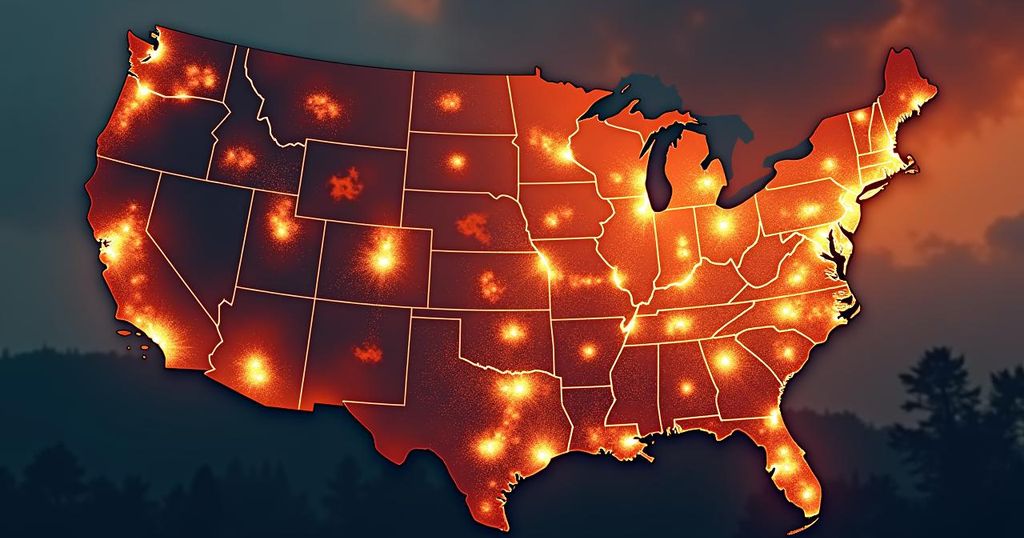Hurricane Helene has highlighted the escalating frequency and severity of climate-fueled storms in the United States, resulting in extensive damage and casualties. Increased atmospheric moisture and rising sea temperatures, driven by climate change, are contributing to more catastrophic weather events. The economic impacts of such disasters are also growing, with Helene projected to cause up to $250 billion in damages. Experts stress the importance of enhancing infrastructure and community preparedness to mitigate future disasters as climate change escalates.
The United States is increasingly facing devastating natural disasters driven by climate change, with Hurricane Helene exemplifying this trend. When Helene struck Florida and moved through the eastern U.S., it resulted in over 180 fatalities and significant destruction, shocking many despite prior warnings about its potential impact. Florida’s Big Bend, which had not seen a direct hurricane strike in decades, was hit hard, and North Carolina, once deemed a refuge from severe weather, faced unprecedented flooding. As climate change continues to escalate, the frequency and intensity of natural catastrophes are rising, causing severe economic implications. The atmospheric changes attributed to global warming result in more volatile weather patterns. Mari Tye, a scientist from the National Center for Atmospheric Research, points out that half of the U.S. population resides near the coast, making them vulnerable to hurricanes and the effects of an aging infrastructure ill-equipped to handle today’s climate demands. In North Carolina, economic losses from disasters have surged from an average of one or two billion-dollar incidents per year from 1980 to 2009, to about six or seven reported annually now, coinciding with significant population growth. Victims of Hurricane Helene, for instance, may endure weeks without essential services such as water and electricity due to extensive damage to infrastructure and communities. Ken Buell of the U.S. Energy Department emphasized the complex nature of restoration efforts impacting recovery speed. The financial burden of disasters is climbing steeply, particularly as the value of real estate continues to rise. Chuck Watson of Enki Research noted that the U.S. median home price has doubled since 2000, contributing to the ease with which damages can reach billion-dollar thresholds. Helene’s estimated total damages are projected to reach $250 billion across multiple states, marking it as one of the costliest storms in U.S. history. Texas remains at the epicenter of extreme weather in the U.S., having recorded more than 180 disasters resulting in billion-dollar losses since 1980, far surpassing that of other states. In recent months, Texas has faced a series of destructive events, from wildfires to tropical storms, exacerbated by record ocean temperatures and increased moisture from a warming world. Experts like Deborah Brosnan and Jennifer Francis assert that the rising global temperatures are fueling more severe weather conditions. For instance, warmer oceans bend hurricane patterns to maintain intensity longer over land, affecting regions that traditionally are not prepared for severe weather. Furthermore, escalating climate impacts, such as heat waves and droughts, pose additional challenges to agriculture, infrastructure, and community resilience. The situation presents pressing questions about preparedness for climate impacts. Daniel Swain, a climatologist from UCLA, underscored Hurricane Helene as a stark reminder that the potential for extreme weather events is rising significantly. Moving forward, there is a shared responsibility to ensure vulnerable communities are equipped for future climate-related threats, incorporating the crucial discussions surrounding the role of climate change in these disasters.
The increasing prevalence of severe weather events across the United States is linked to climate change, which exacerbates the intensity and frequency of storms, floods, and wildfires. As populations expand, particularly in coastal areas, the risks associated with such disasters are amplified, revealing significant vulnerabilities in infrastructure and preparedness. Climate scientists are noting that higher global temperatures are contributing to more extreme weather patterns, requiring a reevaluation of how communities respond to and plan for these events.
In conclusion, the implications of Hurricane Helene and similar natural disasters underscore the urgent need for enhanced climate preparedness and infrastructure resilience. The increasing economic costs and the challenge of adapting to a changing climate necessitate a collaborative approach focused on community safety and sustainability. As the frequency of extreme weather continues to rise, adapting practices and policies to mitigate their impact will be crucial for safeguarding lives and property.
Original Source: www.insurancejournal.com





